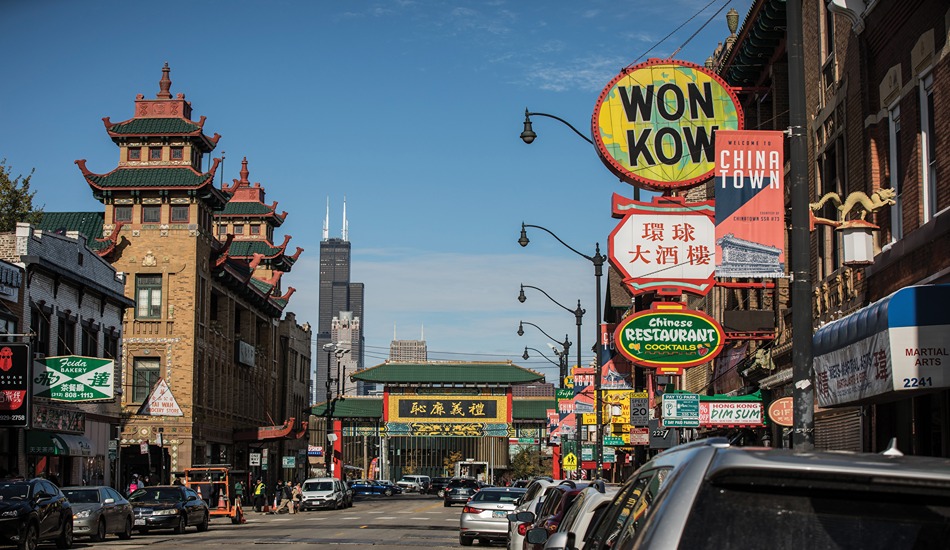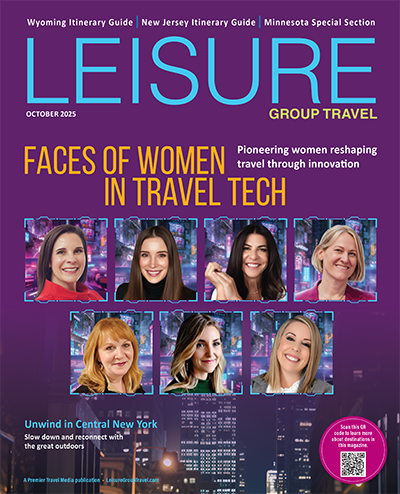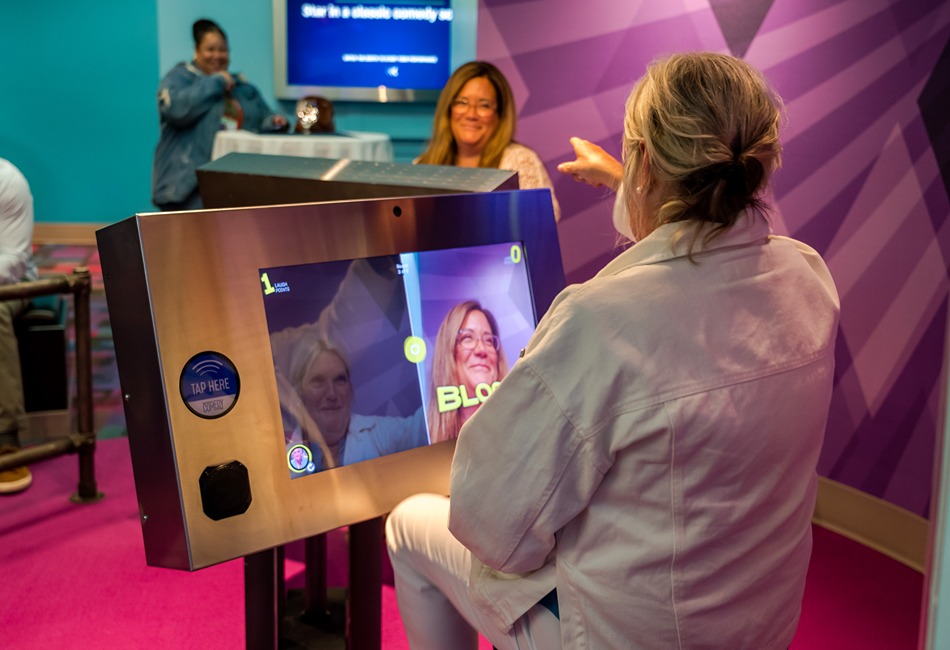Add a dash of international flair to your itineraries with visits to Chicago’s ethnic neighborhoods and other pockets of foreign culture
Without crossing the borders of Illinois, travelers can immerse themselves in the sights, sounds and tastes of far-flung lands. Just by including a visit to a museum, historical site or lively retail corridor, savvy tour planners spice up their trips by whisking their groups, at least vicariously, from the heart of the Midwest to Mexico, Europe or Asia.
Chicago’s Ethnic Neighborhoods
Experience Chicago’ Chinatown
Of Chicago’s many ethnic neighborhoods, Chinatown is the favorite of tourists. Group members enjoy perusing the gift shops and tasting cuisine from all parts of China. Foodies can further immerse themselves in the culture by dropping into bubble tea shops, sampling bakery treats and checking out grocery stores where little English is heard.
The picturesque Chinatown Gate heralds the entrance to South Wentworth Avenue, the main drag. Another photo op awaits at the pedestrian-friendly Chinatown Square mall, where 12 bronze animal statues in the plaza represent the signs of the Chinese zodiac. A mural depicts the history of Chinese immigrants in America.
At the Chinese American Museum of Chicago, exhibits include Great Wall to Great Lakes: Chinese Immigration to the Midwest, Chinese Cuisine in America: Stories, Struggles and Successes and My Chinatown: Stories from Within, the latter with video interviews of Chinatown residents. Idyllic Ping Tom Memorial Park, its entrance adorned with four pillars carved with dragon designs, provides great skyline views of the Loop, a short distance to the north.
Walk Down Devon Avenue
For a trip to South Asia, groups can head to the West Ridge neighborhood on Chicago’s far North Side, home to Chicago’s Indian and Pakistani communities. A mile-long stretch of Devon Avenue, the main thoroughfare of the area commonly called Little India, is lined with dozens of South Asian businesses. Visitors can tap into the exotic vibe by browsing in the sari and jewelry shops, feasting on kebabs and curries, and buying spices and chutneys from grocers.
Guided “Taste of India” food walks offered by the National Indo-American Museum provide samplings of Indian street foods and tell how Indian Americans have revitalized the historic, formerly Jewish neighborhood, a melting pot also populated by people from Sri Lanka, Bangladesh and countries outside of South Asia. Metro Chicago claims the second-largest Indian American population and the fourth-largest Pakistani American community in the country.
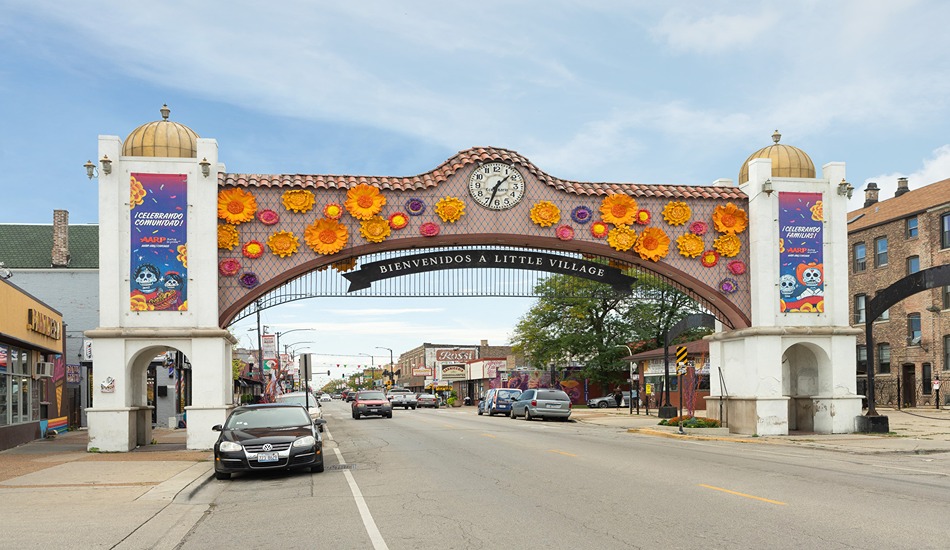
Little Village Neighborhood in Chicago
Chicago’s Little Village
Authentic slices of Mexican-American life also mark Little Village, a neighborhood adjacent to Pilsen. The bustling 26th Street corridor is one of the busiest shopping districts in all of Chicago. Little Village, or “La Villita,” also has a burgeoning arts scene.
Andersonville on Chicago’s North Side
Andersonville, another lively North Side community, is historically Swedish, though it now is a mosaic of multi-ethnic shops and restaurants. Those searching for its Swedish roots will find them at the Swedish American Museum, a treasure house of art and artifacts with a focus on Swedish immigration. Its gift shop abounds with handcrafted Scandinavian gifts. Ann Sather restaurant, a neighborhood standby for decades, is famed for its gooey cinnamon rolls and serves Scandinavian specialties like Swedish pancakes with lingonberries.
Experience Polish Heritage in Chicago
Docent-led tours are available at the Polish Museum of America in West Town, which encompasses what was once Chicago’s “Polish Downtown,” a commercial area centered at Division Street, Milwaukee Avenue and Ashland Avenue. Located in the headquarters of the Polish Roman Catholic Union of America, the museum boasts the biggest collection of Polish artifacts outside of Poland. A trip to the Old Country features exhibits of folk costumes, crafts and military paraphernalia, plus paintings and sculptures. One collection salutes the life of pianist, composer and statesmen Ignacy Paderewski. There is memorabilia spotlighting Pope John Paul II, American Revolutionary War heroes Tadeusz Kosciuszko and Casimir Pulaski, and the early history of Poles in Chicago. The metropolitan area has the largest Polish population of any city outside of Warsaw.
Chicago’s Famous Ukrainian Village
Reminders of Chicago’s Eastern European heritage also are found in Ukrainian Village, a neighborhood northwest of the Loop. Named for the influx of immigrants who began settling there in the late 19th century, it has become trendy with young professionals but maintains evidence of its Slavic identity. With Russia’s war on Ukraine raging, Ukrainian Village has been grabbing national attention. Of special interest are Ukrainian shops, three major Ukrainian churches and two museums.
The Ukrainian National Museum of Chicago displays religious and military artifacts, folk costumes, artwork, crafts, richly woven and embroidered textiles, and has an impressive collection of Ukrainian Easter eggs (pysanky). Another gem is the Ukrainian Institute of Modern Art.
The Ukrainian Village Landmark District includes early 20th century workers’ cottages and churches like the 1903 Holy Trinity Orthodox Cathedral, a building designed by famous Chicago architect Louis Sullivan and distinguished by gilded cupolas; group tours are available. Also worth a look are the 1915 St. Nicholas Ukrainian Catholic Cathedral and 1973 Sts. Volodymyr and Olha Ukrainian Catholic Church. All have beautiful iconic paintings, mosaics, stained glass and chandeliers.
For tastes of Ukrainian Village, Shokolod Pastry and Cafe offers traditional foods like borshch (beet soup), varenyky (pierogis, served with sour cream) and Ukrainian cheese pancakes. It has space that accommodates large groups.
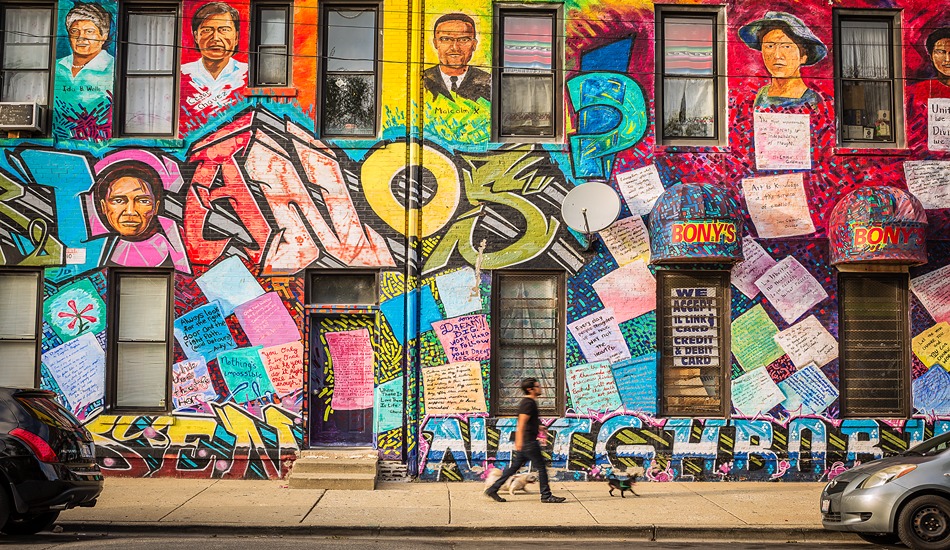
Street Murals in Pilsen, Chicago
The Pilsen Neighborhood of Chicago
Chicago’s Pilsen neighborhood, southwest of the Loop, showcases Mexican-American culture through the lens of bold, color-splashed street murals and a thriving art scene. The prime retail strip, 18th Street, abounds with Mexican restaurants, bakeries and grocery stores. Art galleries and studios along several blocks of Halsted Street make up what is known as the Chicago Arts District. The free-admission National Museum of Mexican Art, the largest Latino museum in the country, has everything from ancient artifacts and folk art to textiles and photography. October programming features traditional Day of the Dead altars from artists around the nation.
Greektown in Chicago
Greektown, once home to Chicago’s Greek community, is now a lively commercial strip along a five-block stretch of South Halsted Street in the West Loop. Both tourists and locals come to indulge at restaurants dishing up Greek favorites like gyros, braised lamb in tomato sauce, moussaka (layers of eggplant, zucchini, potato and bechamel sauce) and saganaki, a flaming appetizer of pan-fried kaseri cheese delivered to the table with great flourish. The Greek language is still heard in the neighborhood, and the community comes out in full ethnic pride during the annual Greek Independence Day parade, the Taste of Greektown open-air summer festival and the days surrounding Greek Easter.
The National Hellenic Museum, a modern building on Halsted, is the only museum of Greek culture in the United States. Exhibits trace Greek heritage back to ancient times and tell the story of the immigrant experience in America.
Explore Humboldt Park
Monumental iron Puerto Rican flags on bustling Division Street serve as the gateway to Paseo Boricua, the cultural heart of Humboldt Park, home to Chicago’s Puerto Rican community. The street is lined with public art and ethnic eateries where visitors will want to try a jibarito, a plantain sandwich invented in the neighborhood. Paseo Boricua Tour Company offers walking tours led by a lifelong resident, and lunch can be included. The National Museum of Puerto Rican Arts and Culture is housed in the former horse stables of Humboldt Park, a peaceful greenspace with gardens and lagoons.
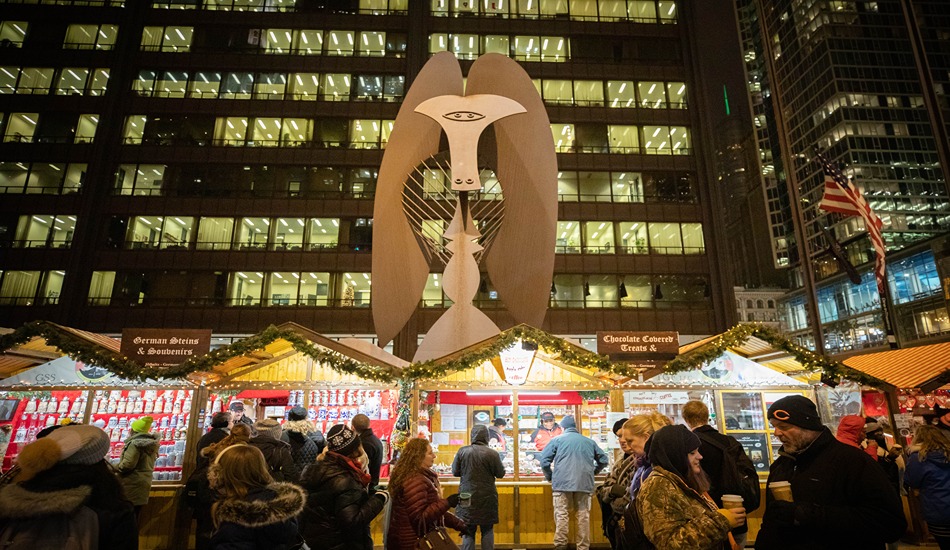
Seasonal Christkindlmarket in Chicago
Seasonal Events in Illinois
During the holidays at Daley Plaza in the Loop, Christkindlmarket transports merrymakers to the festive Christmas markets of Germany. From mid-November to Christmas Eve, candy cane-striped tents manned by some 50 vendors from Germany, Austria, Poland and other countries brim with high-quality, handcrafted imports—ornaments, wooden toys, nutcrackers, Nativity sets, jewelry, cuckoo clocks, the list goes on. Food and drink stands offer German beer and spiced wine, fresh pretzels, roasted nuts, gingerbread, apple strudel, sausages, sauerkraut and potato pancakes. Other Christkindlmarket locations are Wrigleyville (next to the Chicago Cubs’ ballpark) and RiverEdge Park in downtown Aurora, west of Chicago.
Another Chicago holiday tradition is Christmas Around the World, the Museum of Science and Industry’s grand exhibition of 50-some Christmas trees decorated by groups according to their ethnic traditions.
Illinois Attractions Beyond Chicago
BAPS Shri Swaminarayan Mandir
In west suburban Bartlett, groups can take an imaginary trip to India by visiting BAPS Shri Swaminarayan Mandir, the largest Hindu temple in North America. Built in 2004 with more than 7,000 tons of Turkish limestone and Italian Carrara marble, it dazzles visitors with its luminescent pinnacles, exotic domes, and photogenic fountains and gardens. Carved teak, shipped in whole pieces from India, decorate the temple (mandir) and adjacent Cultural Center, the starting point for tours. Inside the marble-and-granite place of worship are images of deities and intricately carved screens, pillars, ceilings and arches. The exhibition Understanding Hinduism sheds light on a religion practiced by one of every seven of the world’s people.
Dutch Heritage in Fulton
Travelers get a taste of Dutch culture in the Mississippi River town of Fulton, where a major attraction is De Immigrant Windmill. Manufactured and partially assembled in the Netherlands, it produces stone-ground buckwheat, corn, rye and wheat flours that are sold in the gift shop at the Windmill Cultural Center, which features more than 20 European windmill models. The Dutch Days Festival celebrates Fulton’s Dutch heritage the first weekend in May with a parade, arts and crafts, Dutch foods and klompen dancers in wooden shoes.
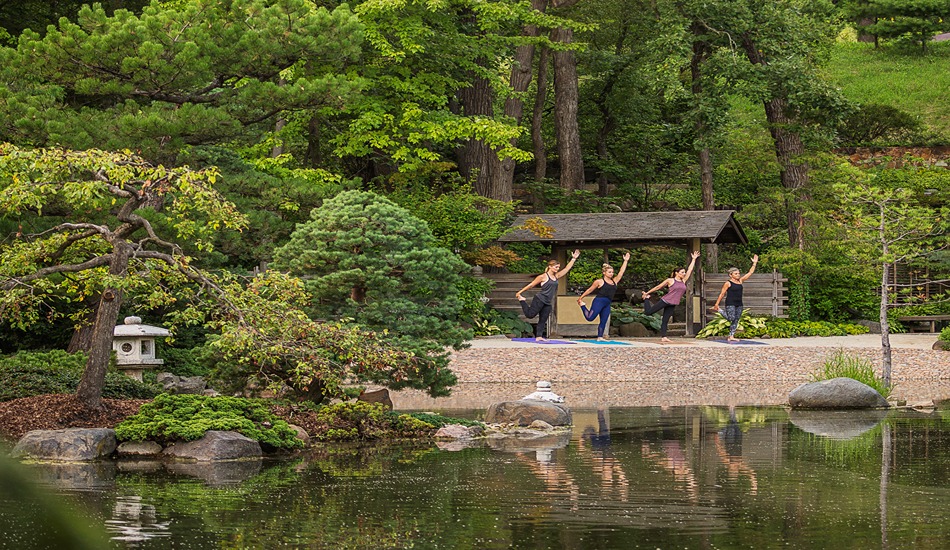
Yoga Class at Anderson Japanese Gardens
Anderson Japanese Gardens in Rockford
Groups can commune with the spirit of the Land of the Rising Sun at Anderson Japanese Gardens in Rockford. Recognized as one of the most authentic Japanese gardens outside of Japan, the 12-acre oasis includes a tea house, ponds, decorative bridges, stone sculptures, coin basins, examples of Japanese carpentry and a waterfall made of 700 tons of boulders. At Japan House on the University of Illinois campus in Urbana, groups can walk through the gardens and arrange a traditional tea ceremony or flower arranging workshop among other cultural experiences.
Bishop Hill in Western Illinois
In western Illinois, a utopian colony founded by a group of Swedish religious dissenters has been preserved for its historical significance. Bishop Hill State Historic Site includes buildings dating back the 1840s, when the prairie community thrived economically. Groups can tour the Colony Church and Bishop Hill Museum, shop for Swedish-themed items at the old-fashioned general store, pop into stores to see artisans making brooms and pottery, and enjoy Swedish meatballs and noodles at P.L Johnson’s. The entire village of Bishop Hill is a National Historic Landmark.
Illinois has plenty of attractions and activities for travelers and groups to enjoy. If you’d like to learn even more about things to do in Illinois, be sure to Subscribe to Leisure Group Travel magazine for FREE and get even more vacation ideas.
By Randy Mink


